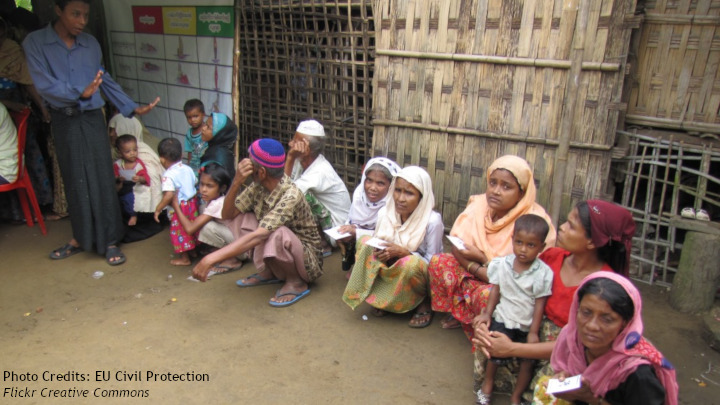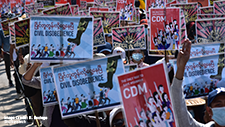Mental Illness: Myanmar’s Hidden Epidemic

Elliot Brennan
Myanmar urgently needs to improve mental health care and achieving that objective will require a change of attitude by policy makers and the wider community.
A report released last year by the Ministry of Health and Sports showed some modest but important improvements in health indicators. In a worrying development though the report devoted less than a page to mental health.
The mental health information in the Public Health Statistics Report 2014-2016 was incomplete and did not elaborate on figures that cause concern. For example, why was the rate of mental retardation for every 100,000 people three times higher in Chin State and six times higher in Kayah State than the national average? The report, in its omissions, showed how far mental health awareness and care has to go in Myanmar.
The 1912 Lunacy Act, which is more legal than medical in assessing mental health disorders, is Myanmar’s most up-to-date law on mental health. That this legislation is still in effect shows how far Myanmar lags behind in an important area of public health policy. The National League for Democracy government’s ambitious health reform plan, A Roadmap Towards Universal Health Coverage in Myanmar (2016-2030), relegates mention of mental health to a subset of non-communicable disease for funding purposes.
Spending on health has increased from a woeful 0.2 percent of GDP in 2009 to more than one percent in 2014, though this still lags behind other countries in the region and is well behind developed countries. Within this low figure, only 0.3 percent is spent on mental health, says the World Health Organization. Resources are similarly negligible. There are only two specialised mental health hospitals in Myanmar, in Yangon and Mandalay, and only 70 specialised drug treatment centres and mental health wards.
Yangon and Mandalay have 2.5 beds for mental health patients for every 100,000 people, while other states and regions have 0.3. Worse, according to the head of psychiatry at Yangon University, is that in 2016 there was only one psychiatrist for every 260,000 people – that is, around 200 in the whole country.
With such a dearth of capacity, the public health system cannot help even a fraction of patients. Improved home care services are desperately needed. WHO figures show that chronic patients occupy 60 percent of inpatient beds in mental hospitals in Myanmar. As well as skewing overall available bed figures, this further stigmatises mental health disorders and may discourage help-seeking behaviour.
The knock-on effect on society of not treating mental health illness is immense. For example, research from the United States in 2012, where one in 17 has a serious mental illness and one in two will suffer some form of mental ill health during their lives, estimated the loss in productivity at more than US$100 billion a year.
In Myanmar, according to data from the Institute for Health Metrics and Evaluation, mental and substance use disorders cause the loss of millions of years of healthy life. These disorders account for at least five percent of Myanmar’s total disability affected life years, or DALYs, which are the sum of the years of potential life lost due to premature death, ill health or disability.
Those figures put mental disorders in the top 10 diseases in Myanmar in terms of DALYs as well as in terms of overall prevalence and incidence of disease. However, these already strikingly large numbers fall short of global averages for mental health disorders, which are at least twice as big and growing, raising concern that the data is incomplete. Myanmar’s health system in general suffers from a serious lack of data collection and analysis capability, and these figures suggest that the same is true for Myanmar’s data on mental health.
What is worse is that the data suggests that the problem is growing. Global Burden of Disease data shows that DALYs for mental health and substance use disorders in Myanmar for both sexes and all ages have steadily increased from 1,500 DALYs for every 100,000 people in 1990 to 1,638 for every 100,000 in 2016. These figures do not take into account self harm (1.67 percent of total DALYs) or interpersonal violence (1.91 percent of total DALYs), which often have a component of mental ill health attributed to them.
Similarly, post-traumatic stress disorder is not observed in this data but given repressive government in the past and continuing civil conflict it is highly likely to be prevalent. The data shows that we can only see the tip of the iceberg of mental health disorder in Myanmar and that the growing problem needs urgent attention.
Significant trauma
What the data cannot always communicate in Myanmar’s context is trauma. There is a causal relationship between trauma and the onset of some mental health disorders and many in Myanmar have endured trauma for decades. For half a century, the military ruled by fear and used torture and other violence against dissidents, and supporters or members of ethnic armed groups. Mass displacement due to war or natural disaster has occurred for decades and has particularly affected ethnic minorities in border areas, and more recently, caused the massive exodus from Rakhine State.
Although there is a dearth of academic literature on trauma in Myanmar, studies in countries that are culturally or politically similar, as well as migrant studies, suggest the presence of significant hidden trauma among the Myanmar population.
The WHO suggests that the global prevalence rate of Post Traumatic Stress Disorder among people affected by conflict is 15 percent, and 17 percent for depression. The prevalence rate of PTSD related to natural disasters is harder to identify but is estimated at between 8.6 percent and 57.3 percent.
Myanmar and the wider region are disaster prone. Although other Southeast Asian countries developed psychosocial and mental health plans after the devastating 2004 tsunami, Myanmar did not. That failure to act exacerbated the impact of Cyclone Nargis in 2008, when at least 138,000 people died and 800,000 were displaced. Since then, deadly flooding, earthquakes and drought have plagued the country. The psychological impact of such traumatic incidents from disaster is largely unknown but applying even the most conservative figures to those displaced by Cyclone Nargis would suggest that it left 69,000 people with some symptoms of PTSD.
Natural disasters are only one cause of trauma in Myanmar. Past and present conflict is another source of traumatic stress in all communities throughout the country that the government needs to address to support a healthier population.
Overseas studies of newly arrived refugees from Myanmar suggest that traumatic disorders are prevalent. One study of new arrivals in Australia in 2011 found that 9 percent had PTSD, 20 percent suffered from anxiety and 36 percent were depressed. Although this can partly be attributed to post-migration trauma, researchers also noted existing or pre-migration trauma in Myanmar.
Using WHO global prevalence rates as a baseline, recent disasters and conflict would suggest the number of people in Myanmar exposed to circumstances conducive to traumatic stress and associated mental health disorders is well into the millions. Because this hidden epidemic is largely untreated it is restraining progress in Myanmar.
Tertiary problems
The solutions must come from both government and wider society. Traditional beliefs may significantly determine an individual’s response to traumatic events and associated mental health. These beliefs may also worsen existing mental health and substance use disorders by presenting a barrier to treatments that are not culturally appropriate. These include the belief in the efficacy of traditional healers and religious officiants employed to treat illness.
Consulting astrologers is common and can complicate treatment by supporting fatalistic notions already present within Buddhism. Interventions that do not account for these predispositions may fail. Interestingly, some research elsewhere in Asia has identified a greater resilience in people of Buddhist faith. This may be explained by fatalistic paradigms that promote greater acceptance of misfortune, such as karma and its link to reincarnation. Although this, if proved in further studies, may be beneficial in terms of societal resilience it also leads to fatalistic notions that blame people with mental illness as somehow deserving their ailment because of their past karma.
The solutions needed from government are more straightforward. Increased awareness and funding for mental health programmes are essential, as is the need for the government to address structural factors that hinder effectiveness and access to treatment. A core problem is that pharmaceutical treatments are available in major cities but counterfeit drugs are ubiquitous. Figures are scarce but treatment, where it exists, is reportedly affordable, or even free to patients who cannot otherwise pay. However, the Yangon Mental Health Society in 2016 estimated a 90 percent treatment gap for mental illness.
Another considerable impediment is the high cost of health care in Myanmar. In 2014, some 81 percent of health spending came from citizens’ own pockets, against a global average of 32 percent. This fell to 65 percent in 2015 and the NLD government aims to eventually cut it to 25 percent. The National Health Plan 2017-2021 targets universal access to a basic essential package of health services by 2020. If realised, the boost to psychosocial health would be considerable. Later iterations of the packages should focus specifically on addressing mental health.
The government also needs to help those providing the support. The lack of treatment and facilities to care for people with mental health and associated disorders means that the responsibility for care falls on family members. This has a host of unintended consequences, including a deepening financial burden and, under stress, proliferating mental health disorders within the family. One study has suggested that trauma and mental ill health also adversely affects health workers. Improving capacity and relieving pressure on those caring for the mentally ill would ease the burden and improve economic productivity and overall quality of life for individuals, families and society.
No health without mental health
The Global Mental Health Movement, launched by venerable medical journal The Lancet in 2007, has at its axiom that there is no health without mental health. Ill health often leads to poor mental health and vice versa, and the combination of the two complicates diagnosis and treatment. In light of Myanmar’s ambitious healthcare targets, applying this foundation may lower costs and speed up results.
As The Lancet notes, low-cost mental health care is feasible, affordable and effective. It can be as simple as organised exercise regimes and can be delivered by health workers or through community programmes. As Myanmar has already shown with its successful efforts to combat HIV and TB, information campaigns can help to achieve health goals more quickly and cheaply. Even brief interventions by primary health care professionals are effective in combatting substance abuse. If delivered as part of a primary care service, interventions for depression are highly cost effective.
The disease burden of many mental health disorders – a measure that takes into account financial cost, mortality and several other indicators – are very high compared to other categories of disease. Sufferers and their families can live with a disorder for years, often their entire lives. Addressing mental health means addressing many of the causes of ill health that have the highest burden on populations. It also means improving overall quality of life for many.
Compared to other forms of healthcare, treatment of mental ill health demands less advanced technology and less expensive equipment than it does trained personnel. Myanmar’s healthcare system is already oriented towards training a large workforce of non-specialist community health workers.
A similar approach would benefit mental health. Many resources already exist for early crisis or disaster intervention, such as the WHO-UNHCR’s mhGAP Humanitarian Intervention Guide, which offers advice for non-specialist health care providers. Engaging in training, in partnership with the WHO, UNHCR or with NGOs, could significantly increase the number of trained people who are able to respond to a natural disaster or outbreak of violence. Interventions that properly care for people at the outset may reduce long-term mental health problems.
Addressing mental health in society would be a boost to the economy. Globally, one in four families has a member with a mental illness. If, for example, this average applies to Myanmar, improving home-based care or access to appropriate treatment could relieve stress on a quarter of households, greatly improving productivity.
Contending with decades of neglect, the reform of Myanmar’s health sector has far to go. However, the current lack of emphasis on mental health may ultimately have a long-term destabilising and detrimental impact on the country, its people and the economy. The government, NGOs and others in Myanmar would do well to repeat the refrain: There’s no health without mental health.
Related Publications
-
ISDP Annual Report 2023
ISDP’s Annual Report for the year 2023. We look back on 2023, a year in which tensions and conflicts captured the strategic space in ISDP’s focus areas, making headlines around […]
-
Climate Security in the Indo-Pacific: Priorities and Challenges
The climate vulnerabilities of the Indo-Pacific region have grown immensely with grave implications for regional, national, human, and ecological security. Climate action has been prioritized by most countries, including by […]
-
On the Path to Civil War: Beijing Navigates Post-Coup Myanmar
Abstract Protests against the military’s February 1 coup d’état continue in Myanmar. On March 27, the bloodiest day yet, over 114 civilians, including many children, were shot by regime forces. […]


